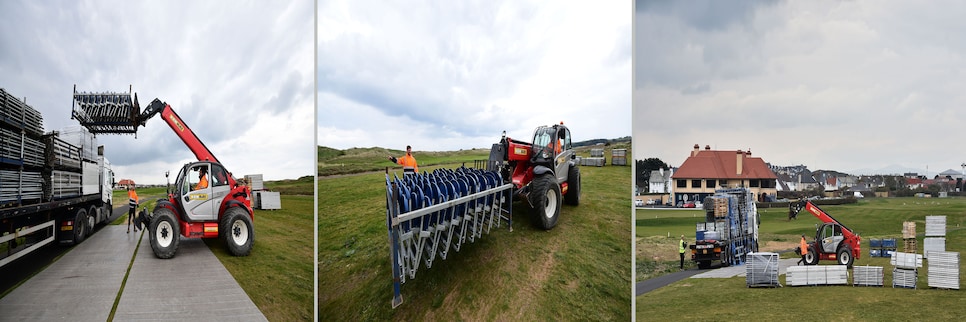News
British Open 2019: What it took to turn Royal Portrush into a fully loaded Open Championship venue

PORTRUSH, Northern Ireland — If you build it, they will come. The R&A’s Johnnie Cole-Hamilton wasn’t quite familiar with the prominent line from the American movie “Field of Dreams,” and swears there were no voices whispering in his head over the last four months as he watched the transformation of Royal Portrush from classic links course to fully loaded Open Championship venue. But as the executive director of championships for the R&A, and the man responsible for building the infrastructure for the historic staging of this year’s Open, the mantra unknowingly applied.
“We always felt like bringing the Open here would be a memorable experience for the people in and around Portrush and all of Northern Ireland as well as for the championship,” he said. “And we’re anxiously awaiting that to come true this week.”
With the Open last held at Portrush in 1951, local enthusiasm for its return has been dramatic. In a first, the R&A capped ticket sales for the Open, and officials are projecting a sellout of 237,750 spectators for the week. If that comes to pass, it would make Portrush the second-highest attended Open in history, passing Birkdale’s 237,000 in 2017 and surpassed only by St. Andrews’ 239,000 in 2000.
Setting aside the political conflict that made the Open’s return to Northern Ireland an impossibility for many years, once the principals at Portrush (most notably club secretary Wilma Erskine) had convinced the R&A that the club was prepared to host once more, Cole-Hamilton was one of the key figures with the governing body to help get it done.
Much has been made of the efforts in the years leading up to 2019 to get Portrush—the club and the community—updated to hold a modern Open. On the macro level, there was the need for land to build 215,000 square feet of tent space for a spectator village. The club approved using the Dunluce Course’s old 17th and 18th holes for this space, with two replacement holes built by Martin Ebert (the seventh and eighth) on adjoining property. Ebert also added 22 new bunkers and five new greens to get the new Dunluce Course Open ready.

Additionally, there was the installation of more than 40 miles of pipework, 40 miles of control cable and more than three miles of roads created, including an underground tunnel beside the new eighth green and ninth tee for players to use to allow for better spectator flow in that part of the course.
“We’ve had the experience of having a clean canvas at Hoylake for the 2006 Open,” Cole-Hamilton said, “and similar in 1999, there was a long return from Carnoustie. We loved the challenge and embraced it.”

With those efforts accounted for thanks to financial investments by the club, local government and the R&A that collective ranged in the millions of pounds, along came several micro issues, although none could be confused with being small. For the first time in his 20 years working on the Open, Cole-Hamilton had to figure out how to get the majority of the materials for the tented village and grandstands shipped not by motorway but by water.
“We’ve never experienced having to take 2,000 lorries over on a ferry,” he said. “What if we had a real bad period of weather where the Irish Sea was too choppy to cross?”
Transport over to Belfast and Dublin began in the first few months of 2019, and went smoothly enough to allow for the onsite building to commence on schedule in early April. One adjustment from year’s past, according to Cole-Hamilton, was the need to bring in additional supplies to accommodate unforeseen issues.
“What if something doesn’t work, or if pieces of grandstand are missing?” he said. “In the past, I can make a phone call and it’s driven overnight. Here that’s a bit harder. We had to have more pieces so if a door came off in the media center, we had a spare.”
The other issue that had the R&A’s attention was the potential for the U.K.’s split with the European Union—infamously known as Brexit—to become official in the spring of 2019, and in turn creating its own set of logistical issues.
“One of the key cornerstones of Brexit [negotiations] is how the border between the Republic of Ireland [which is not part of the U.K.] and Northern Ireland would work, and how that would have worked for us when we ship things to Dublin versus Belfast,” Cole-Hamilton said.

Andrew Redington/Getty Images
The delayed vote on Brexit meant certain contingency plans became moot. It’s an issue that could impact the R&A’s planning for future Opens (specifically how it gets supplies from continental Europe), but one that won’t be clear until the politicians work through their own issues.
By early July, most of what spectators walking the course—and fans watching worldwide on TV—will see at Portrush was in place and ready when the golf world descends on the tiny seaside town.
Asked how the setup went compared to ordinary years, Cole-Hamilton was slow to respond, least he jinx himself. “I’ve never known an easy, easy Open,” Cole-Hamilton said. But how would this one rank on his easy scale? “I would say very high.”
As are expectations for the remainder of the week. Moreover, locals should take pride in the fact that during Wednesday’s R&A press conference, chief executive Martin Slumbers referred to the Open rota as being 10 links courses strong, one more than he referenced the previous year. The implication being that it won’t be another 68 years before the Open returns to Portrush.

